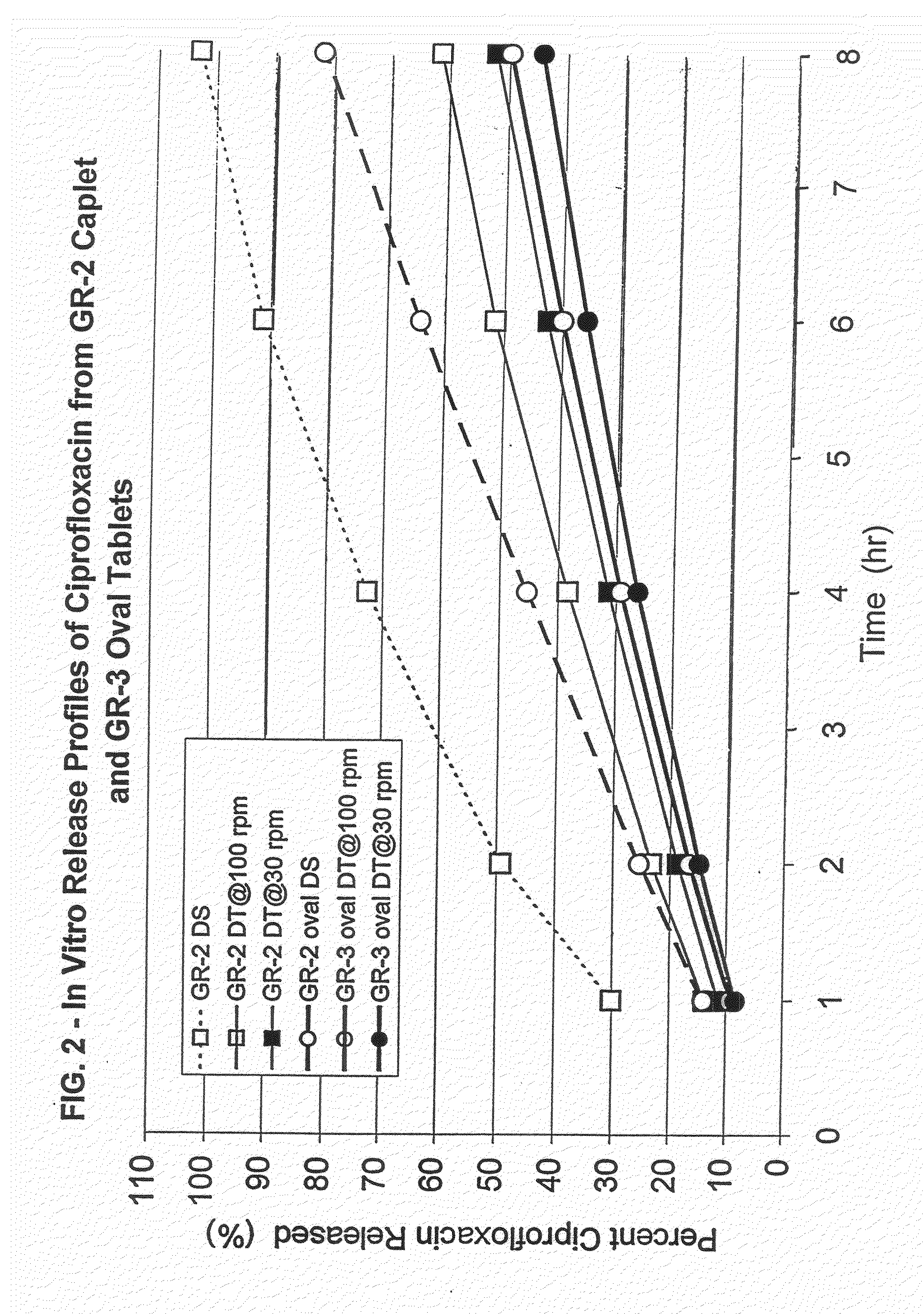Gastric retentive oral dosage form with restricted drug release in the lower gastrointestinal tract
a technology of gastric retentive and oral dosage form, which is applied in the direction of tetracycline active ingredients, drug compositions, microcapsules, etc., can solve the problems of pseudomembranous colitis, unsatisfactory release of certain types of pharmacologically active agents or fragments thereof into and the like, to minimize the variability of patient-to-patient delivery and minimize the effect of the lower gastrointestinal tra
- Summary
- Abstract
- Description
- Claims
- Application Information
AI Technical Summary
Benefits of technology
Problems solved by technology
Method used
Image
Examples
example 1
[0148]Drug dosage forms containing ciprofloxacin hydrochloride were prepared in the form of compressed tablets comprised of swellable, erodible matrix particles with the active agent therein. The matrix particles in the tablets were formulated so as to contain, in a 950 mg tablet, 582 mg ciprofloxacin hydrochloride (equivalent to 500 mg ciprofloxacin), at least one poly(ethylene oxide) (number average molecular weight indicated below), magnesium stearate or stearic acid as a lubricant, and optionally a poly(vinylpyrrolidone) (PVP) hinder. The formulation of each dosage form was as follows:
[0149]Formulation GR-1 (caplet, 8.75×635×19.09 mm):
[0150]61.35 wt. % ciprofloxacin HCl
[0151]14.78 wt % Polyox® WSR N-60K
[0152]21.87 wt. % Polyox® WSR N-80
[0153]2 wt. % stearic acid
[0154]Formulation GR-2 (caplet, 8.75×6.43×19.09 mm):
[0155]61.35 wt. % ciprofloxacin HCl
[0156]36.65 wt. % Polyox® WSR N-60K
[0157]2 wt. % stearic acid
[0158]Formulation GR-3 (oval tablet, 10.05×7.15×18.05 mm):
[0159]61.66 wt....
example 2
[0171]The results of the above in vivo study indicated that the release profile of the GR dosage form should be optimized to take advantage of the average gastric residence time. The individual results from the three subjects showed a high degree of variability, due in part to the variability in the rate of drug release from the tablet (i.e., the difference between the disintegration and dissolution release profiles). In order to minimize patient-to-patient variability, formulations were modified so that the in vitro release profile obtained using a disintegration test would approximate the dissolution release profile.
[0172]The evaluation procedures were the same as those described above, and the formulations together with the symbols used in FIG. 5 where the results are plotted, were as follows:[0173]Squares, solid line: Dissolution test results for 81.62 wt. % ciprofloxacin HCl,[0174]13.86 wt. % Polyox® WSR N-60K, 2.52 wt. % PVP, 2.0 wt. % magnesium stearate.[0175]Tablet dimension...
example 3
[0223]Two formulations (500 mg) of gastric retentive tablets of ciprofloxacin hydrochloride were fabricated under GMP conditions at MDS Pharma Services (Tampa, Fla.). To ensure that ciprofloxacin would not be delivered to the colon, the period of 90% drug release in USP Type I dissolution testing (0.1 N HCl, 100 rpm, pH=1) was designed to be approximately 6 hours. Since retention and drug release represent a balance between swelling and erosion, respectively, 2 formulations were selected. One formulation involved conventional tableting (GR-A) and the other swelled to a greater extent to ensure retention, but was more difficult to manufacture (GR-B). Immediate release tablets (500 mg, Cipro®, Bayer) were used as obtained. The compositions of GR-A and GR-B are given below.
[0224]GR-A: 74.26 wt. % ciprofloxacin HCl, 20 wt. % Polyox® 1105, 4.74 wt. % PVP.[0225]1.0 wt. % magnesium stearate. Tablet dimensions of 10.1×6.5×18.1 mm, tablet weight of 796 mg (containing 508 mg ciprofloxacin).
[0...
PUM
| Property | Measurement | Unit |
|---|---|---|
| time | aaaaa | aaaaa |
| pH | aaaaa | aaaaa |
| pH | aaaaa | aaaaa |
Abstract
Description
Claims
Application Information
 Login to View More
Login to View More - R&D
- Intellectual Property
- Life Sciences
- Materials
- Tech Scout
- Unparalleled Data Quality
- Higher Quality Content
- 60% Fewer Hallucinations
Browse by: Latest US Patents, China's latest patents, Technical Efficacy Thesaurus, Application Domain, Technology Topic, Popular Technical Reports.
© 2025 PatSnap. All rights reserved.Legal|Privacy policy|Modern Slavery Act Transparency Statement|Sitemap|About US| Contact US: help@patsnap.com



